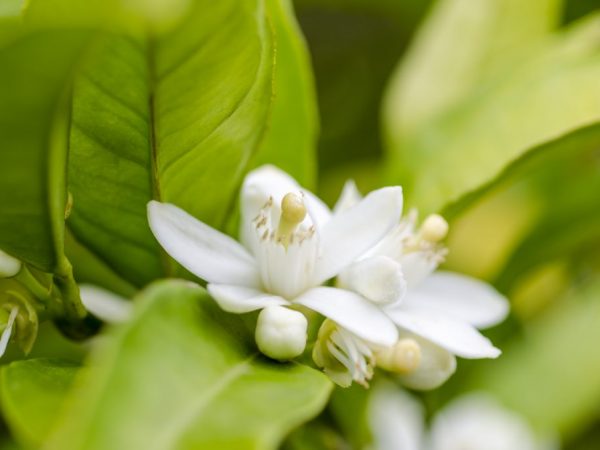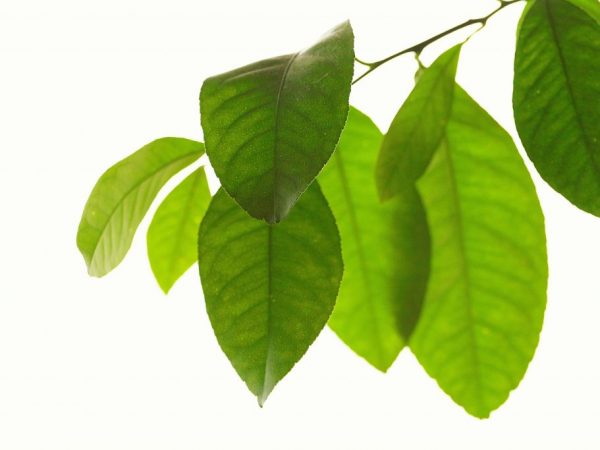Lemon Blossom
Lemon blooming is a mesmerizing sight. The plant smells delicious. After flowering, the first fruit begins to be tied. It takes a lot of work and citrus care to make it ripe.

Lemon Blossom
Features of citrus care
Blooming lemon needs special care, different from the conditions of keeping the plant during the dormant period. Citrus bloom lasts about 7 days. During this time, an inflorescence is formed on the branch, consisting of 5 or more flowers.
But the fruits from this are not tied in bunches, because most of them are male, and their role is reduced to pollination of the female flower. It is easy to determine which flower forms the ovary, and which one is needed only for pollination, because they have a different structure.
Male flower stalks do not bloom immediately, but at different times. This is because the female shoot is not immediately ready for fertilization. Flowers of different sexes do not need to be thinned out.
The budding period of indoor citrus, under proper indoor conditions, begins at the end of February. Favorable conditions include:
- nutritious soil;
- abundance of sunlight;
- stable temperature.
Conditions for flowering
Lemons are classified as subtropical plants, therefore, in order to achieve fruiting at home, they are provided with conditions similar to natural ones. Only a seedling that has reached the age of 3 years will be able to make it bloom and bear fruit.
But not all indoor citruses bloom. A seedling that has undergone budding and received a cutting from a fruiting plant blooms and begins to bear fruit earlier than the one grown from a seed at home.
Lemons bloom if you follow the requirements for their cultivation:
- Providing daylight hours more than 12 hours. For this, the pot is placed on a windowsill facing the south or southeast side. On the north side of the house, the seedling will neither bloom nor develop properly. In some cases, fluorescent lighting is allowed.
- Warm water with mineral fertilizers dissolved in it contributes to the formation of the correct crown and the appearance of flower buds. Citrus is watered twice a day, and on hot days it needs additional spraying.
- High humidity. During bud formation, the seedlings are sprayed with warm water. This is done carefully, trying to avoid droplets getting into the sinuses. The spray left on the leaves is also harmful. The foliage can be burned.
If the lemon does not bloom

The plant can be made to bloom
To make a lemon bloom, which has borne fruit earlier and stopped blooming at home, it will turn out by providing the plant with:
- Plenty. A pot of citrus fruits that do not bloom is placed separately from other plants, because in natural conditions a lemon is a spreading tree.
- Trimming the crown. The procedure begins to be carried out already in the first year of a lemon's life, and continues throughout the entire growth period. At the first stage, the indoor seedling is shortened so that 4 buds remain on it, and the main trunk rises no more than 20 cm above the ground.After that, the plant will begin active growth of shoots, on which there will certainly be flower buds.
- Transplant. The reason for the lack of flowers is an unsuitable pot. That is why plants that are in no hurry to bear fruit should often be transplanted into large containers. In pots, it is required to provide good drainage.
Pests can also interfere with the setting of buds and the flowering of lemon. They undermine the health of the seedling, and instead of fruiting, citruses fight for life. Before carrying out the above procedures, treat the tree from late blight, soot fungus, mold, as well as living parasites. For the fight, traditional agricultural products are used: broad-spectrum fungicides, Bordeaux mixture or insecticides.
Post-flowering care
After completing the flowering process, the plant needs to be looked after more responsibly.
Care procedures:
- Regular watering. Lemon flowers form an ovary, and in order to maintain it, you will have to water the plant as the topsoil dries up. For convenience, cover the soil at the base with black spandbond with a high degree of water permeability, and vinegar is added to the water itself for irrigation. For 1 liter of liquid put 1 tbsp. l. product.
- Top dressing. A fruiting tree will need to be fed with a complex mineral preparation intended for introduction into the soil before and after the flowering of the citrus tree. It is better if the fertilizer contains nitrogen. The accompanying components should be phosphorus, potassium, sulfur, calcium and magnesium. Good results are obtained by preparations based on humate.
- Abundance of light. The citrus pot on which the fruits appeared should not be rotated and rearranged from place to place. The slightest change in the usual conditions is fraught with the fact that the ovary will disappear.
- Lack of drafts. For a tree, it is preferable to choose a place that is well protected from the movement of air masses. Do not leave the pot by the open window. Strong winds have a detrimental effect not only on citrus flowers, but also on fruits.
Conclusion
Caring for indoor flowering citrus takes a lot of time and a responsible approach. Watering, feeding and replanting a citrus tree should be the entire period of its life.
This is the only way to achieve citrus flowering at home to taste the fruit grown by your own hands.


